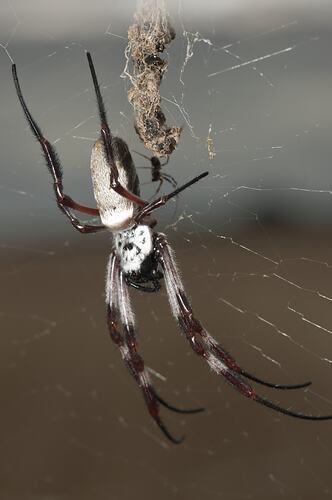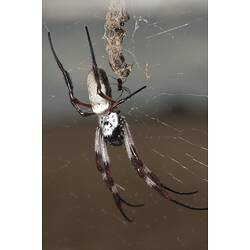General Description
Abdomen elongated and silver in colour. Head covered with white hairs. Legs a brown-red, darker around the joints, with patches of black hair. Female up to 24 mm, males up to 6 mm.
Biology
Females usually live around a year and die shortly after producing egg sacs in the late summer and autumn. The webs are not taken down and rebuilt each night as happens in some species of orb-weavers. The web also gives the species their common name. The webs are yellow or cream but when sunlight reflects off them they appear to be golden. The webs are often in the tree canopy in windy areas to catch insects. Thay are complex 3 dimensional shapes that can be more than a meter across. One female lives on a web, usually with several much smaller males. The female constructs a beautiful golden silk egg sac during early winter which is usually left in the tree that she constructed her web on. This is one of the largest orb-weavers in Australia. Golden Orb-weavers can be locally common, for example in the Darling Downs in Queensland a single dead tree can have as many as 30 individual golden orb weaver webs.
Distribution
Australia wide.
Habitat
A variety of landscapes across Australia, often found in subrurban gardens.
More Information
-
Animal Type
-
Animal SubType
-
Fast Fact
The webs are so strong they can even entangle small birds.
-
Brief Id
Large silvery spider with hairy patches on legs. Webs are large and appear golden in sunlight.
-
Colours
Silver, Red, Brown
-
Maximum Size
24 mm
-
Habitats
-
Diet
Carnivore
-
Diet Categories
Invertebrates
-
Hazards
Rarely bites, though bites are painful. May cause redness and mild pain around the site of the bite or nausea and dizziness.
-
Endemicity
-
Commercial
No
-
Taxon Name
-
Scientific Author
(Labillardiere, 1799)
-
Common Name
Australian Golden Orb-weaver Spider
-
Kingdom
-
Phylum
-
Subphylum
-
Class
-
Order
-
Infraorder
-
Family
-
Genus
-
Species Name
edulis



